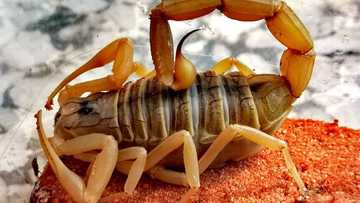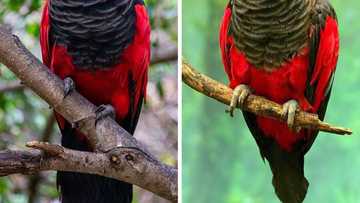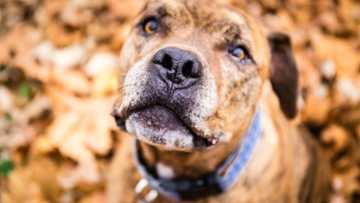Snakes of South Africa identification guide 2022 with pictures
Most people are afraid of snakes and are right in doing so because a snake bite can be fatal. An interesting fact is that most species are harmless. Educating yourself about snakes is therefore crucial to help you release some of the fear. Here is a guide on snakes of South Africa identification.

Source: UGC
South Africa has a number of dangerous snake species, but people rarely die from their bites. These species have venom that is used for hunting and protection. The venom may be neurotoxic (affecting the central nervous system), cytotoxic (destroying cells and tissues), or haemotoxic (causing haemorrhaging and internal bleeding).
Why is snake identification important?
Snake encounters are rare in South Africa, even in the wild. In case you come across one, it will only bite if you are very close to it.
In the event of a bite, it is easier to get appropriate antivenom if you can tell the type of snake that bit you. There are two types of antivenom, polyvalent (for cobra, mamba and viper bites) and monovalent (for boomslangs bite).
How do I tell what kind of snake I have?
There are certain factors you need to understand when it comes to snake identification. Here are the top 6 aspects to consider. These aspects have nothing to do with the snake being venomous or non.
1. Snake distribution
Different locations are dominated by different species. If you know the dominant types in a specific area, it will be easy to narrow down the species you are likely to encounter. For example, large black snakes in the Western Cape are likely to be Black Spitting Cobras or Mole Snakes while Black Mambas are common in North Pretoria. Some species will also appear at certain times during the day.
2. Scales
The scales, especially on the head, are also helpful in narrowing down many possible options. Some species have smooth scales, while others are keeled. Different species have varying scale counts and patterns. You should take a picture of the snake that has bitten you if it is safe to do so.
3. Color and patterns
Different species have varying colours and markings. Certain species have one solid colour for the whole body or one colour on the dorsal side and a different one on the belly. Some may also look similar, but there is a distinguishing colour trait that will help you tell them apart, for example, a unique marking on the neck or head.
4. Length and width
A snake’s length and thickness are hard aspects to estimate. You can make estimates using surrounding objects. Different species will also have different tail lengths and bulkiness. The head could be elongated or short and round. Other body aspects to consider are the masculinity and flatness of the body.
5. Eye characteristics
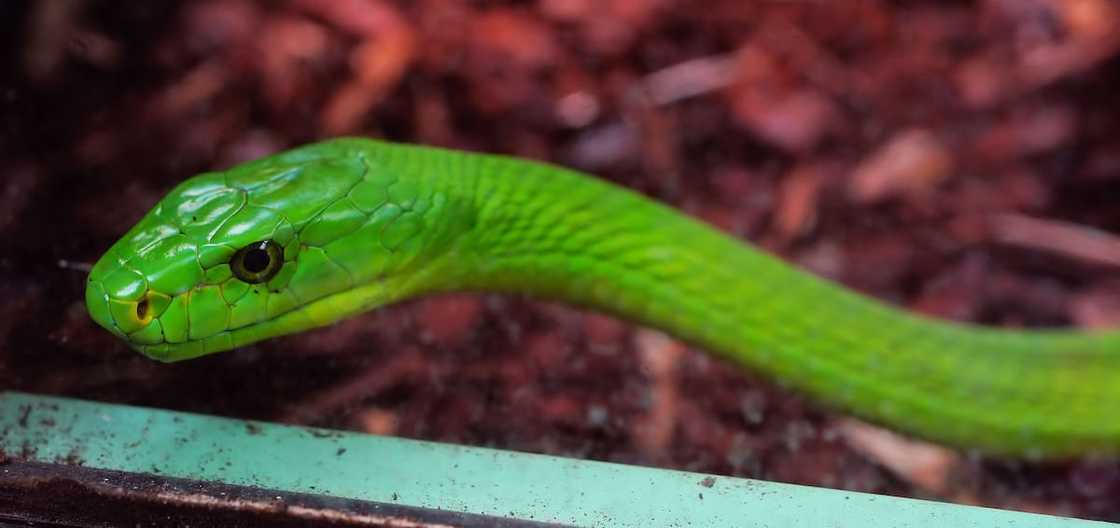
Source: UGC
Things to look for are the eye colour, size, and location on the head, as well as the pupil shape. Snake identification experts reveal that the pupil shape is the only aspect that might show if the snake is poisonous or not. Most species with slit-shaped pupils are venomous.
6. Behavior
A snake’s behaviour is essential when trying to identify them. For example, when threatened, common slug-eaters curl into balls, rhombic egg-eaters hiss as they coil and uncoil, while heralds make their heads flat. However, sometimes snakes exhibit similar behavioural traits when ambushed, thus confusing people. For example, mole snakes lift their heads and flatten their necks, a defensive trait that is also exhibited by cobras.
What kind of snakes are in South Africa?
It is estimated that the Southern part of Africa has about 170 snake species and sub-species. Less than half of these species are dangerous. It is not common for people to die from snake bites, and South Africa records about 10 deaths annually. Here are the top 14 snakes of South Africa one is likely to encounter.
1. Black Mamba (Dendroaspis polylepis) – Venomous

Source: Twitter
Black Mambas are the longest species in Africa with measurements of between 2.5 and 4.5 meters. They are characterized by a potent neurotoxic venom that might kill if a polyvalent antivenom is not used to treat on time. Black Mambas are common in KwaZulu-Natal and game parks. The green mamba is also poisonous.
2. Cape Cobra (Naja Nivea) - Venomous
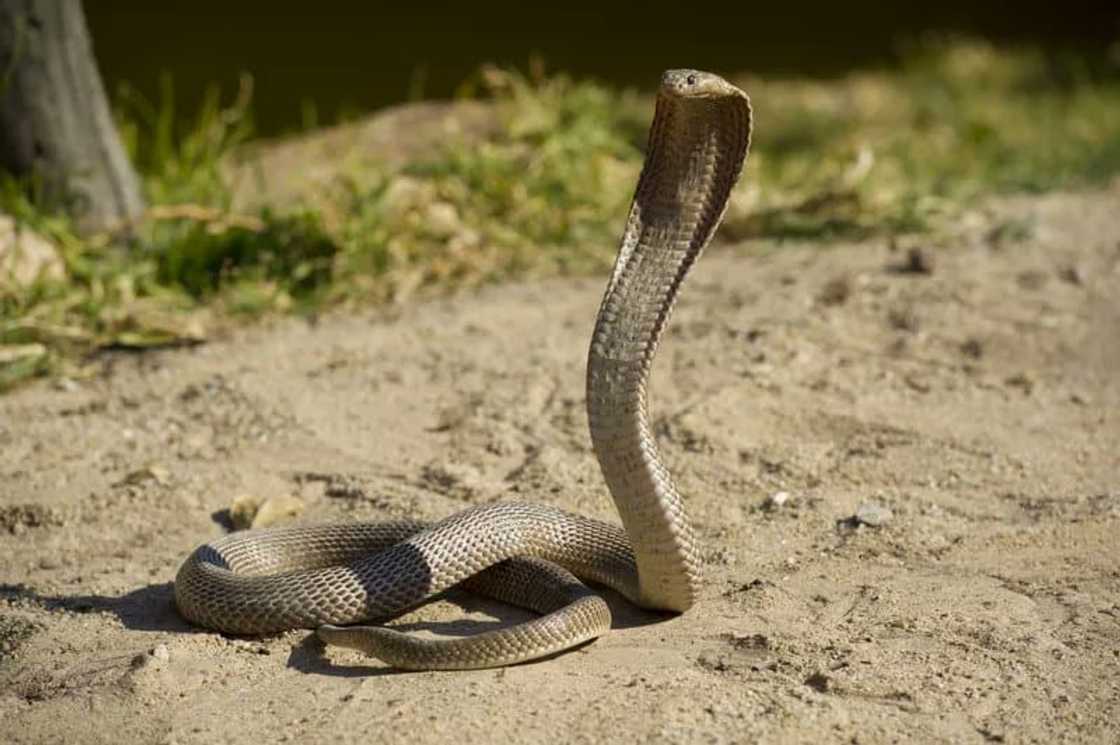
Source: Twitter
Cape Cobras have potent neurotoxic poison that can be treated with polyvalent antivenom in the case of a bite. These species are prevalent in the Western Cape. They can also be encountered in the North West, Eastern Cape, Northern Cape, and Free State.
Cape Cobras are easy to differentiate from other cobras because of their black tail tip. Young ones have a black throat that fades with age. The species have varying colours that include different shades of yellow and brown.
3. Mozambique Spitting Cobra (Naja mossambica) - Venomous

Source: Twitter
The Mozambique Spitting Cobra can spit their venom with high accuracy that can reach targets that are up to 3 meters away. Their poison is effectively treated with polyvalent antivenom. They are common in Durban, KwaZulu-Natal, and a majority of the Eastern part of South Africa. You are likely to encounter them during the initial rains of summer.
4. Snouted Cobra (Naja annulifera) - Venomous

Source: UGC
Snouted Cobras are prevalent in the Eastern part of South Africa, including North West, Gauteng, KwaZulu-Natal, Limpopo, and Mpumalanga. You are likely to encounter them in grasslands, the savannah, and bushveld habitats.
Their bites are treated as a medical emergency because they have both cytotoxic and neurotoxic poisons. They also have varying colours, including different shades of black, brown, and yellow.
5. Common Boomslang (Dispholidus typus) - Venomous
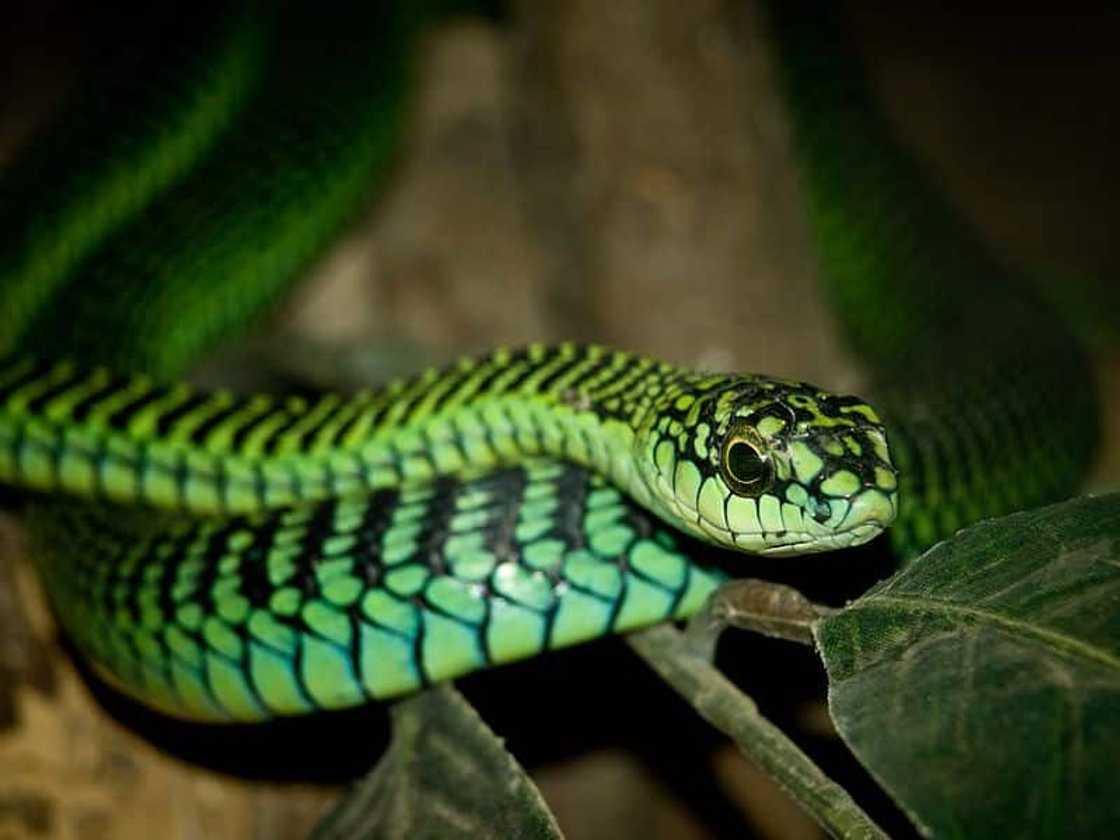
Source: Twitter
Common Boomslang lives on trees and only comes down to eat. They are among the few species whose males and females have different colours. Males are mostly green, while females are predominantly olive, brown, or dull brown.
Boomslangs are naturally docile, and it is uncommon for them to bite people. They have a potent haemotoxic poison that can be treated with monovalent antivenom in the case of a bite.
6. Puff Adder (Bitis arietans) - Venomous
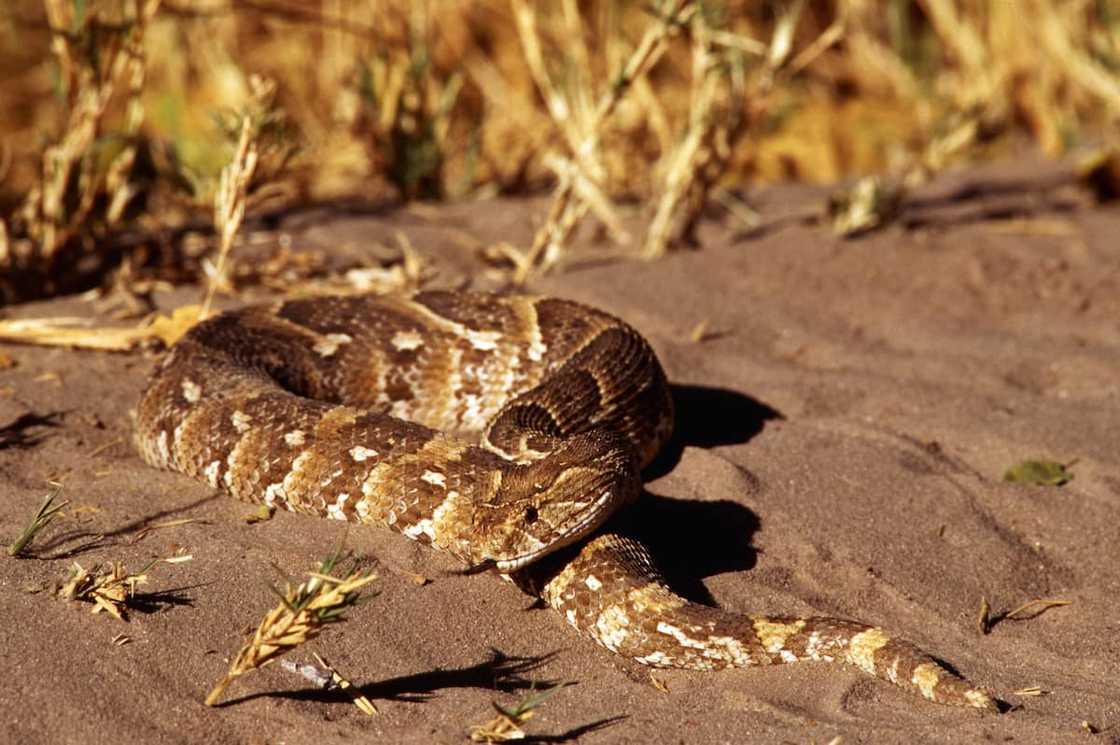
Source: Getty Images
Puff Adder is the most common and widely spread dangerous species in South Africa. They can camouflage as they wait for their prey. They mostly stay in an ambush position for a number of weeks as they wait for prey to pass.
Puff Adders are characterized by a cytotoxic venom that is effectively treated by polyvalent antivenom. Other types of adders or vipers include the berg adder, night adder, and Gaboon viper.
7. Red Lipped Snake/Herald (Crotaphopeltis hotamboeia) – Mildly venomous
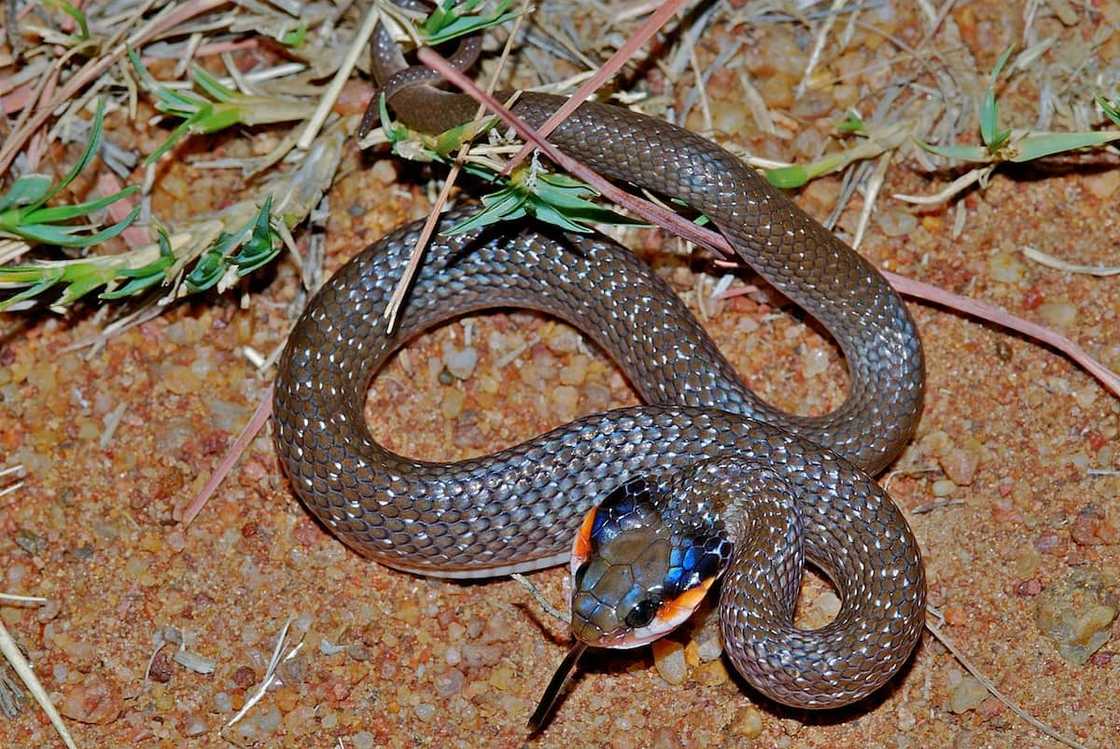
Source: Twitter
The Red Lip Snake feeds mostly on frogs and sometimes lizards and geckos. They live in damp places, and their upper lip may be bright red, orange, yellow, white, or black. The species is found in all nine provinces of South Africa.
8. Black Headed Centipede Eater (Aparallactus capensis) – Mildly venomous

Source: Twitter
These species are small with a black head and brown-reddish or grey bodies. They are borrowers, and they live under the ground and come to the ground during heavy rains to hunt for centipedes. They rarely bite humans, and their bites are medically insignificant.
9. Southern African Python (Python natalensis) – Non-venomous but can bite
This species is common in KwaZulu-Natal. They have about 100 strong and curved teeth and are thus capable of inflicting large bites that must be treated. Pythons usually eat small to medium-sized pets like dogs, but there are no recent records of them eating people in South Africa.
10. Brown House Snake (Boaedon capensis) – Non-venomous

Source: Twitter
The Brown snake South Africa is one of the most common species across the country. They can be identified by two distinct white lines that run down the side of their heads. It feeds on rats, bats, birds, mice, and lizards. Many snake lovers keep it as a pet.
11. Common Slug Eater (Duberria lutrix) – Non-venomous
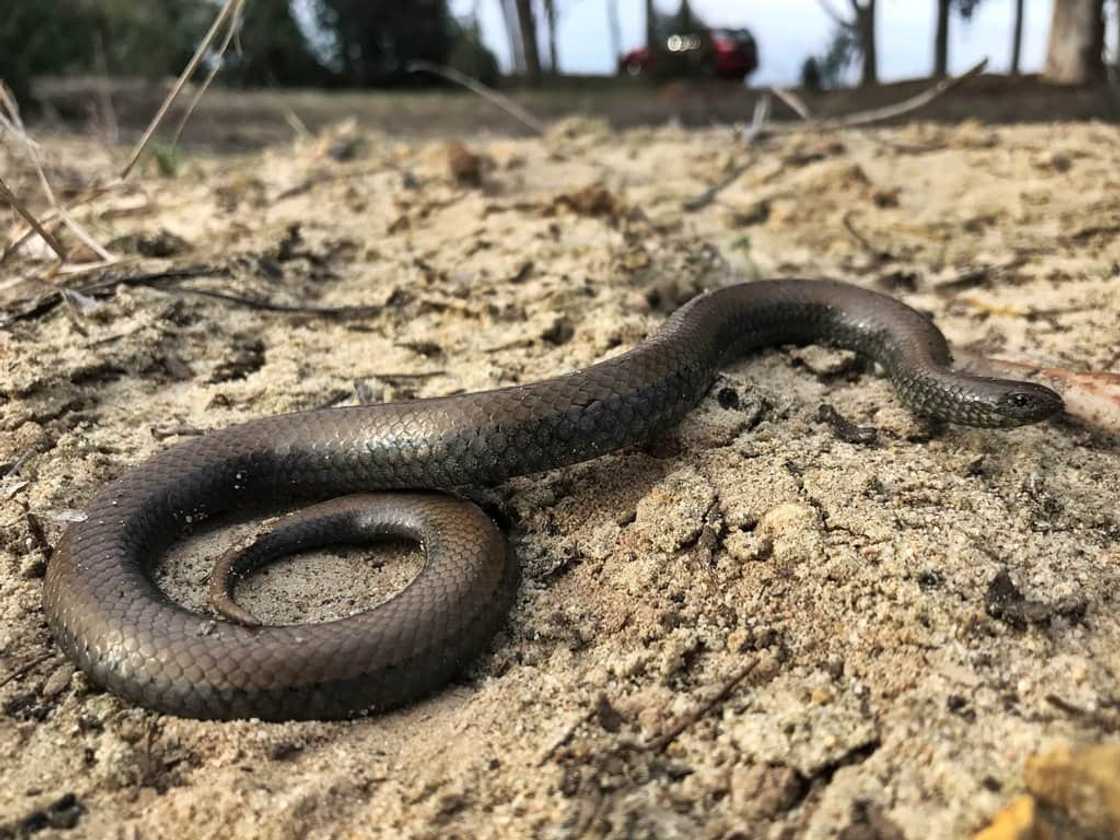
Source: Twitter
Common Slug Eaters feed on snails and slugs and are mainly found in wet places. They are identified by their stocky body and tiny heads. When scared, they release a musk that smells bad and rolls into tight spirals.
12. Rhombic Egg Eater (Dasypeltis scabra) – Non-venomous

Source: Twitter
Rhombic Egg Eaters can be found anywhere in the country. They only eat bird eggs and can go without eating for months during the non-birding season. These species are defenceless. When scared, they make a rasping sound by rapidly rubbing their scales together as they coil and uncoil.
13. Mole Snake (Pseudapis cana) – Non-venomous but aggressive constrictors

Source: Twitter
Mole snakes mostly eat rodents and can also feed on lizards and birds. They are prevalent in Mpumalanga, Free State, and the Western Cape. They have varying colours, including grey, black, salmon, orange, and reddish-brown. Young ones have many patterns that fade as they age.
Mole snakes are aggressive constrictors when threatened. Their bites may be big enough to require medical stitches.
14. Spotted Bush Snake (Philothamnus semivariegatus) – Non-venomous
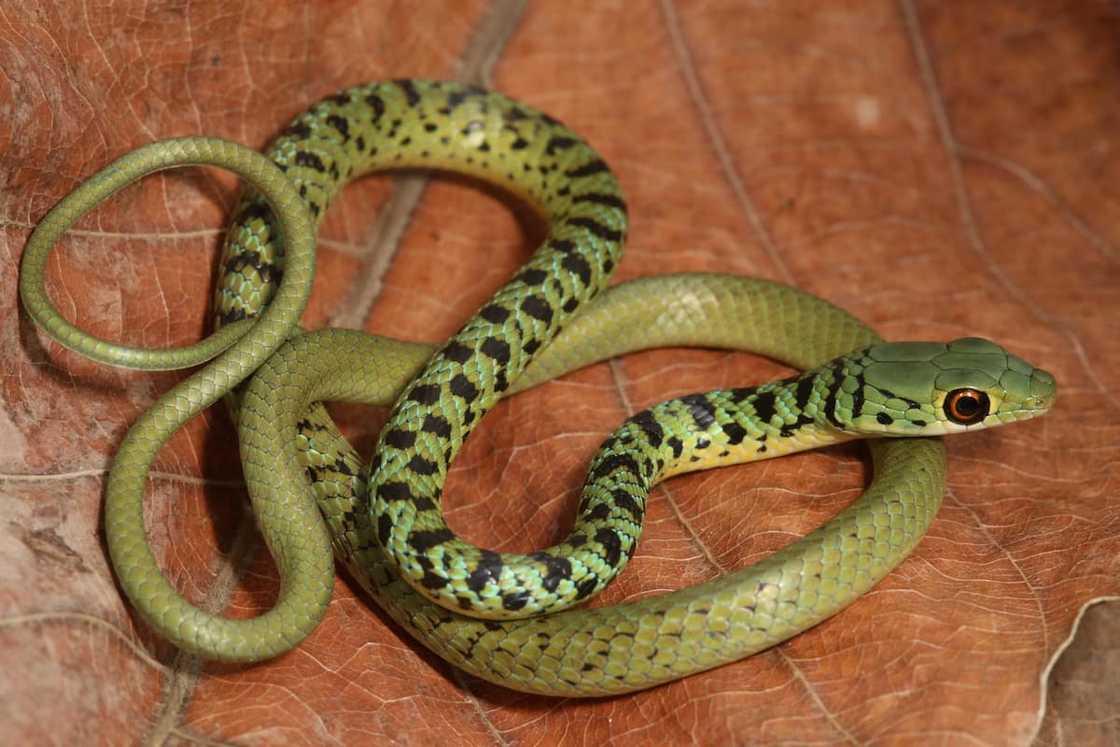
Source: Twitter
The Spotted Bush species feeds mostly on lizards, frogs, and geckos. They find their way into homes as they search for food and are in most cases mistaken for Boomslangs or Green Mambas. They are skilled climbers and often move quickly when scared.
The species may bite but only superficially. They are prevalent in Gauteng, the North West, Limpopo, Mpumalanga, KwaZulu-Natal, and on the East coast of the Eastern Cape.
How can you tell a harmless snake?
There is no clear distinction between dangerous and harmless species. There are many misconceptions when it comes to differentiating them. Most harmless species have a single solid colour although the mambas have this characteristic and are dangerous.
If you take a closer look, which you should not, most have round pupils, but the venomous mamba has the same aspect while the harmless Rhombic Egg-eater has slit-shaped pupils.
Is there an app for identifying snakes?
There are several applications that can help you identify different species. They include SnakeSnap and ASI Snakes.
Snakes of South Africa should be understood by all because you never know when they will bite. It is also crucial that you know how to handle a snake bite.
READ ALSO: Jackie Phamotse: Author accuses celebrities of using snakes for wealth
People across the globe are increasingly living with certain snake species as pets. However, in African culture, these creatures are associated with dark magic. In November 2020, Briefly.co.za reported about Jackie Phamotse’s take on how some of Mzansi’s celebrities earn their wealth and fame.
The controversial author accused famous people of using snakes and witchcraft to get wealth. They, in turn, lie about getting non-existent endorsements. Several celebrities have shared pictures of them posing with snakes.
Check this out: rare beautiful Lorikeet became part of a Russian family. But nobody expected that he would make everyone’s life like hell. Watch the full story to see why.
Source: Briefly News





